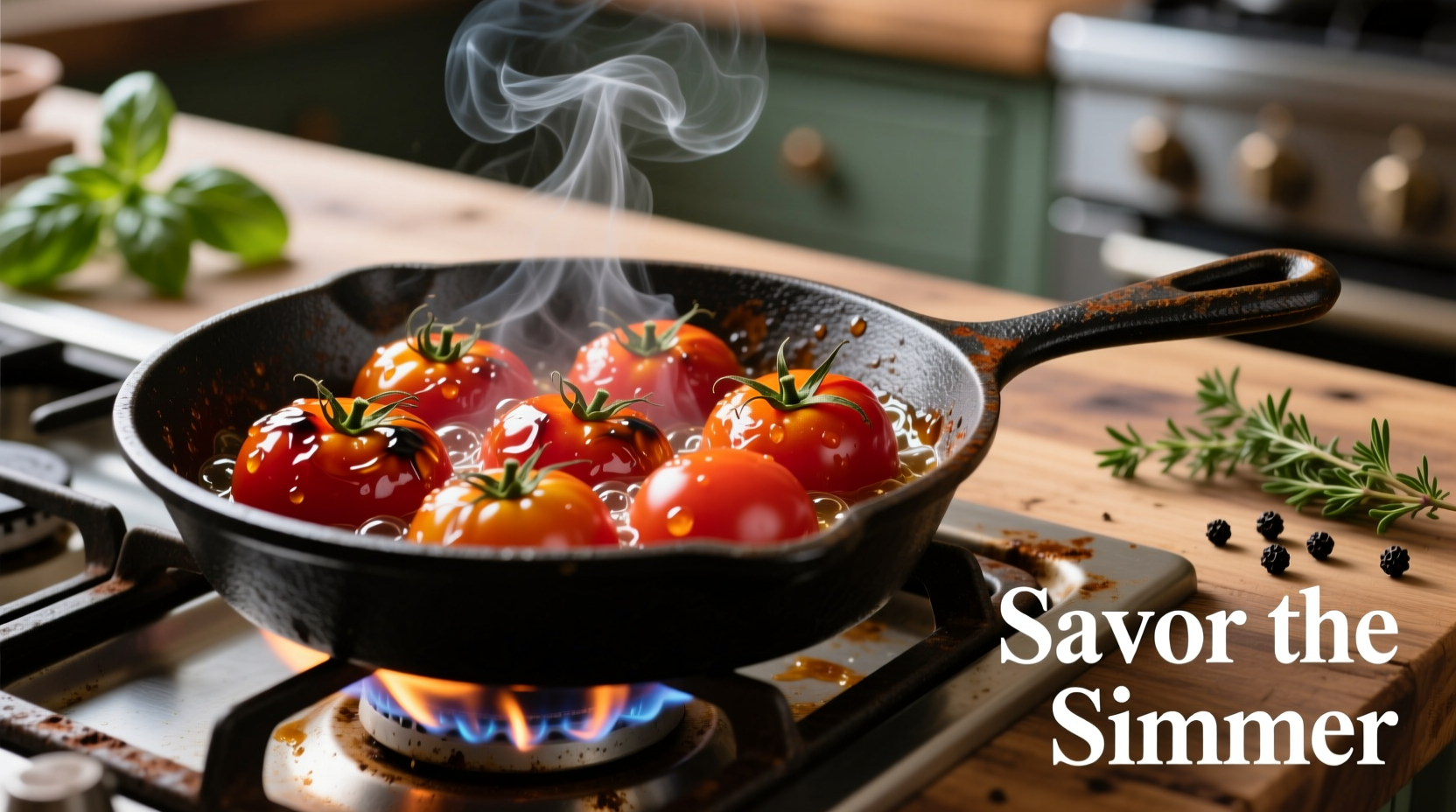The perfect homemade roasted tomato soup starts with high-quality ripe tomatoes roasted at 400°F (200°C) for 40 minutes to deepen flavors, followed by a simple simmer with aromatics and a splash of cream for richness. This method creates a soup with complex caramelized notes that regular stovetop tomato soup can't match, requiring just 90 minutes total time with minimal active preparation.
There's a reason why professional chefs swear by roasting tomatoes for soup instead of boiling them straight from the vine. When you roast tomatoes before making soup, you trigger the Maillard reaction and caramelization that transforms their natural sugars, creating deeper, richer flavors with less need for added sugar or salt. Unlike traditional tomato soup recipes that can taste one-dimensional, homemade roasted tomato soup develops complex umami notes that satisfy even the most discerning palates.
Why Roasting Transforms Tomato Soup Flavor
Food science explains why roasting makes such a dramatic difference. According to research published in the Journal of Agricultural and Food Chemistry, roasting tomatoes at 400°F increases their lycopene content by up to 35% while breaking down cell walls that release more flavor compounds. This process creates new flavor molecules through caramelization that you simply can't achieve with raw or boiled tomatoes.
| Preparation Method | Flavor Complexity | Lycopene Availability | Required Seasoning |
|---|---|---|---|
| Raw tomatoes | Low (acidic, one-note) | 100% (baseline) | High (needs sugar) |
| Boiled tomatoes | Moderate | 115% | Moderate |
| Roasted tomatoes | High (layered, umami) | 135% | Low (naturally sweet) |
This flavor transformation explains why easy roasted tomato soup from scratch consistently outperforms canned or quick-stovetop versions. The roasting process concentrates flavors while mellowing acidity—meaning you'll need less added sugar to balance the soup, making it both healthier and more sophisticated tasting.
Essential Ingredients Checklist
While supermarket tomatoes work in a pinch, your best homemade roasted tomato soup starts with the right produce. According to the USDA's seasonal produce guide, peak tomato season runs from June through October, when field-ripened varieties deliver maximum sweetness and depth.
- Tomatoes: 3 lbs (1.4 kg) ripe Roma or San Marzano (their lower water content creates richer flavor)
- Aromatics: 1 large yellow onion, 4 garlic cloves, 2 carrots (roasted alongside tomatoes)
- Liquid base: 4 cups (950ml) low-sodium vegetable broth
- Flavor enhancers: 2 tbsp balsamic vinegar, 1 tsp dried thyme, 2 bay leaves
- Finishing touch: 1/2 cup (120ml) heavy cream or coconut milk for dairy-free option

Equipment You'll Actually Need
Don't let complicated equipment lists intimidate you. Creating authentic roasted tomato soup at home requires just three essential tools:
- Rimmed baking sheet: For even roasting (a cast iron skillet works too)
- Immersion blender: Creates silky texture without transferring hot liquid (a regular blender works with caution)
- Heavy-bottomed pot: For final simmering to prevent scorching
Professional kitchens often use specialized equipment, but these three items deliver restaurant-quality results in any home kitchen. The FDA's food safety guidelines recommend avoiding aluminum cookware with acidic ingredients like tomatoes, which is why we specify non-reactive surfaces.
Step-by-Step Roasting & Simmering Process
Follow this chef-tested sequence for foolproof homemade roasted tomato soup every time:
Phase 1: Roasting (40 minutes)
- Preheat oven to 400°F (200°C)
- Cut tomatoes in half lengthwise, place cut-side up on baking sheet
- Add halved garlic cloves, sliced onions, and carrots around tomatoes
- Drizzle with 2 tbsp olive oil, 1 tsp salt, and freshly ground black pepper
- Roast 40 minutes until tomatoes collapse and edges brown
Phase 2: Simmering (30 minutes)
- Transfer roasted vegetables to pot, add broth, balsamic vinegar, and herbs
- Simmer 25 minutes to meld flavors (do not boil vigorously)
- Remove bay leaves, blend until smooth with immersion blender
- Stir in cream, adjust seasoning, and heat through (do not boil after adding cream)
Avoid These 3 Common Roasted Tomato Soup Mistakes
Even experienced home cooks make these errors that compromise easy roasted tomato soup from scratch:
- Under-roasting tomatoes: Tomatoes need full 40 minutes to caramelize properly. Cutting time short leaves you with watery, acidic soup.
- Over-blending hot soup: Blending extremely hot liquid creates dangerous steam pressure. Let soup cool 5 minutes before blending.
- Boiling after adding dairy: High heat causes cream to curdle. Keep temperature below 180°F (82°C) after adding dairy components.
Flavor Variations for Different Diets
Adapt this classic roasted tomato soup recipe to suit various dietary needs without sacrificing flavor:
- Vegan version: Substitute coconut milk for cream and use mushroom broth for deeper umami
- Low-sodium option: Increase roasted garlic to 6 cloves and add 1 tsp nutritional yeast for savory depth
- Spicy variation: Add 1 roasted poblano pepper and 1/4 tsp cayenne during simmering phase
- Extra protein: Stir in 1/2 cup white beans during final simmer for creamier texture and added nutrition
Storage & Reheating Guidelines
Proper storage maintains the quality of your homemade roasted tomato soup. Following FDA food safety recommendations:
- Cool soup within 2 hours of cooking
- Store in airtight containers for up to 4 days in refrigerator
- Freeze in portion-sized containers for up to 3 months
- Reheat gently over medium-low heat (never boil)
Interestingly, roasted tomato soup often tastes better the next day as flavors continue to meld. The National Center for Home Food Preservation confirms that properly stored tomato-based soups maintain quality and safety for recommended periods when following these guidelines.
Serving Suggestions That Elevate Your Soup
Transform your simple roasted tomato soup into a restaurant-worthy meal with these finishing touches:
- Drizzle with basil oil (blend 1/4 cup olive oil with 10 fresh basil leaves)
- Add crunch with homemade croutons or roasted chickpeas
- Pair with grilled cheese sandwiches using sharp cheddar and gruyère
- Garnish with microgreens or fresh thyme sprigs for visual appeal
Remember that presentation matters—serve in pre-warmed bowls to maintain ideal eating temperature longer. This professional technique, documented in culinary textbooks like On Food and Cooking by Harold McGee, enhances the overall sensory experience of your homemade roasted tomato soup.
Frequently Asked Questions
Can I use canned tomatoes for roasted tomato soup?
Yes, but with limitations. High-quality canned San Marzano tomatoes can substitute when fresh tomatoes aren't in season, but you'll miss the caramelization benefits of roasting. For best results, drain canned tomatoes thoroughly, toss with olive oil, and roast 25 minutes before proceeding with the recipe to develop deeper flavors.
Why does my roasted tomato soup taste bitter?
Bitterness usually comes from over-roasted garlic or burnt tomato skins. To prevent this, place garlic cloves in the center of the baking sheet (away from direct heat) and check tomatoes at 30 minutes. If skins blacken excessively, remove those pieces before blending. A teaspoon of sugar or honey can balance mild bitterness, but proper roasting technique is the real solution.
How can I thicken roasted tomato soup without dairy?
Several effective dairy-free thickening methods exist: blend in 1/4 cup cooked white beans, stir in 2 tbsp tomato paste during simmering, or puree 1/2 cup cooked rice with the soup. Roasting tomatoes longer (up to 50 minutes) also naturally concentrates flavors and thickens the base by evaporating excess moisture.
What's the best way to freeze roasted tomato soup?
For optimal results, cool soup completely, then portion into freezer-safe containers leaving 1-inch headspace for expansion. Remove air from freezer bags by submerging almost completely in water before sealing. Properly frozen roasted tomato soup maintains quality for 3 months. Thaw overnight in refrigerator before reheating gently over medium-low heat.











 浙公网安备
33010002000092号
浙公网安备
33010002000092号 浙B2-20120091-4
浙B2-20120091-4